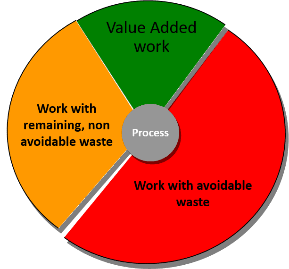In the first of our blogs on Operational Excellence and Lean Operations we introduced you to the concept of all work being made up of three categories.
It is accepted and recognised that all work is made up of three categories
- Value-Added Work – This needs to be maximised
- Work with Avoidable Waste – This needs to be eliminated
- Work with Non-Avoidable Waste – This needs to be minimised

Introduction to the seven wastes
As previously stated the challenge for all organisations irrespective of size is detecting where waste occurs and in what form. It has been discovered through careful study that waste falls into manifests itself in seven accepted categories.
T is for TRANSPORT
The excess or unnecessary movement of goods, product, information or equipment.
I is for INVENTORY
Storing it, recording it, moving it, checking it, searching for it!
M is for MOTION
Walking, bending, stretching, reaching, twisting or turning– closely related to ergonomics!!!
W is for WAITING
Waiting for information, parts, paperwork, schedules, or people. In fact waiting for anything that prevents us from getting on with our work!!!
O is for OVER- PRODUCTION
Making more than the customer wants, providing more information needs or has asked for. Making more than is required is pure waste!!!!
O is for OVER PROCESSING
Doing more to the item that you are producing than is required. Using over complex methods or equipment when a simple approach is adequate.
D is for DEFECTS
Creating products, information or services that do not meet the customer requirements and have to be scrapped, re-worked or re-produced at a cost to the business!!
TIMWOOD is a useful Mnemonic for remembering the seven wastes!
It may be surprising to learn that the products and services physical or administrative that we work on are actually being worked on and value being added for only 5% (approximately) of the total time in process!
The vast majority of the wastes we face in our operations are what can be called “serial killers!” They repeat over and over and are systemic in nature. Our people have often found ways to get around these issues and, as a result we never actually eliminate them.
Until we do address these wastes they will continue to “nickel and dime” our operation to death and we shall be condemned to be victims to them forever!
Did you know?
- In Service industries the cost of wasted time and effort equates to up to 40% of Operating Costs!
- In Manufacturing industries the cost of wasted time and effort equates to up to 30% of Cost of Sales
We have a toolbox that has been developed that can be used to identify and locate these wastes. They are simple, effective methods that utilise our most precious resource, our employees, to attack these wastes and help our businesses to reduce costs, improve customer service, survive and grow!
This blog was written by:
Keith Hoey MBA
Director and Senior Instructor – Keith Hoey and Associates Limited
